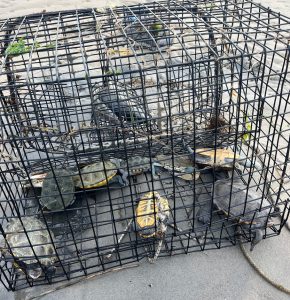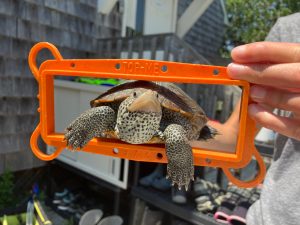by Brian Williamson, Research Scientist
 Diamondback terrapin populations face many threats, but none as widespread or detrimental as bycatch in crab traps. Terrapins breathe air, and can only hold their breath for about 45 minutes during warmer months. As carnivores, terrapins are attracted to bait and crabs within the traps and, once caught, often drown. Adults, juveniles, males, females – all are susceptible to bycatch, which may cause population declines that take many years to restore.
Diamondback terrapin populations face many threats, but none as widespread or detrimental as bycatch in crab traps. Terrapins breathe air, and can only hold their breath for about 45 minutes during warmer months. As carnivores, terrapins are attracted to bait and crabs within the traps and, once caught, often drown. Adults, juveniles, males, females – all are susceptible to bycatch, which may cause population declines that take many years to restore.
One area particularly impacted by bycatch in New Jersey is the Delaware Bay, where crabbing activity is high and many terrapins are captured in traps as bycatch each year. Traps containing terrapins wash up to shore from time to time, but more frequently found are the hundreds of drowned terrapins brought in with the tides after being emptied from traps. It’s likely even more go undocumented. Sometimes, terrapins are found in traps still alive.
On a Delaware Bay beach this summer, our partners at Conserve Wildlife Foundation of New Jersey found two crab traps, recently lost, with bait and eleven terrapins inside. Sadly, one had already drowned. Seven were still alive and able to be released. The remaining three, an adult male and two young but likely mature females, were just barely alive in the traps. With the fortune of timing, these terrapins were able to be resuscitated and released after they recovered strength.
 These traps were not equipped with Bycatch Reduction Devices (BRDs), which restrict the size of trap openings to keep larger terrapins out and allow crabs in. BRDs would have prevented the two female terrapins from entering the trap in the first place, but are currently not required in the Delaware Bay or other large bodies of water in New Jersey. Requiring BRDs on all crab traps set in New Jersey would reduce the impacts of bycatch to terrapin populations.
These traps were not equipped with Bycatch Reduction Devices (BRDs), which restrict the size of trap openings to keep larger terrapins out and allow crabs in. BRDs would have prevented the two female terrapins from entering the trap in the first place, but are currently not required in the Delaware Bay or other large bodies of water in New Jersey. Requiring BRDs on all crab traps set in New Jersey would reduce the impacts of bycatch to terrapin populations.
